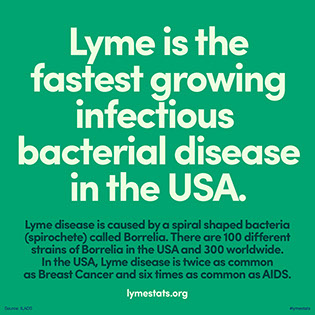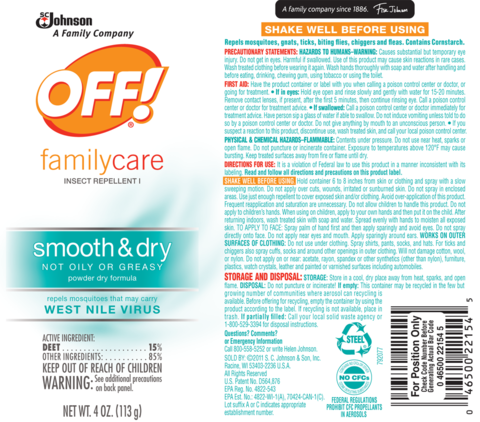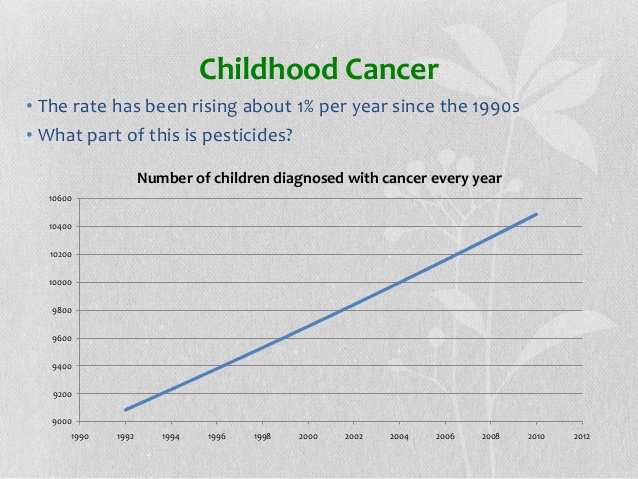***This post has been updated with more current information on the Non Toxic Communities blog***
Lyme disease is a serious infection that can be transmitted by the bite of Ixodes scapularis – more commonly known as the black-legged deer tick. Borrelia burgdorferi, the bacteria that causes Lyme disease, was discovered in the early 1980’s in Old Lyme, Connecticut. Borrelia is a spiral shaped bacteria known as a spirochete. It can cause arthritic, neurological, cardiovascular and many other symptoms.
Less than half of all Lyme patients recall ever seeing a bulls eye rash or being bitten by a tick. Lyme can also be mistaken for many other illnesses thereby delaying proper medical care, and making the infection much harder to treat. The CDC estimates that Lyme disease infects over 300,000 people a year. That is twice as many people diagnosed with breast cancer, and six-times as many people with HIV. Lyme disease is a public health crisis.

Photo courtesy of lymestats.org
Ticks don’t just carry Lyme disease. Powassan virus, Ehrlichia, Anaplasma, and Babesia are just some of the other microbes they can transmit. These tick borne diseases will vary based on locations, and species of tick. It is extremely important for people to be aware of the risk and prevalence of these diseases and to take precautions to avoid being bitten.
Because of the serious nature of these infections, many people use unsafe repellents and yard treatments to try to reduce their risk. Unfortunately, they are simply adding a different type of risk to the equation. According to a randomized control study conducted on the effectiveness of bifrenthrin (a synthetic pyrethroid) over the course of two years found that while the pesticides did reduce the number of ticks, they did not make any significant difference in the number of tick encounters, or the incidence of tickborne illness. This suggests that people are being exposed in other places, not just at home. This underscores the need for appropriate use of repellents and least toxic management strategies for both homeowners and public recreational areas.
Synthetic pyrethroids, (like bifrenthrin used in the study mentioned above) are not a least toxic option. Pyrethroids are commonly used as a yard and clothing treatment for ticks. Like the widely used permethrin, they work by by interfering with basic nerve cell functioning. Studies in mice and rats show that sub-lethal intoxication leads to aggression, hypersensitivity to external stimulation, whole-body tremor, convulsions and paralysis. Permethrin binds tightly to soil and household dust. Permethrin is highly toxic to bees, fish and aquatic organisms. Studies on permethrin have linked it to increased autism risk, and shown it can interfere with the hormones in our bodies. According to the scientists at TEDX:
“One of our primary concerns is recent research demonstrating that permethrin exhibits the characteristics of an endocrine disruptor. Endocrine disruptors are chemicals that interfere with the communication system of glands, hormones, and cellular receptors that control the body’s internal functions. A relatively unique feature of endocrine disruptors is that they exert their effects at extremely low doses, even when higher doses exhibit no adverse effects. Disorders that have increased in prevalence in recent years such as unusual male gonadal development, infertility, ADHD, autism, intellectual impairment, diabetes, thyroid disorders, and childhood and/or adult cancers are now being linked to prenatal exposure to endocrine disruptors.
In the permethrin studies of health effects on the female reproductive system, excessive cell growth was a common finding. In contrast, cell death and reduced tissue weight of male reproductive organs were among the findings on the male reproductive system. One study suggested that the products permethrin breaks down into may be 100 times more potent with regards to endocrine disruption than permethrin itself. Due to the potential endocrine disrupting effects of permethrin, pregnant women should take extra steps to avoid exposure.”
The toxicity of permethrin has been shown to be greatly enhanced when used in combination with DEET, an insect repellent. Given how widely used pyrethroids are, it seems prudent to seek out an alternative to DEET. This is one reason I do not feel comfortable recommending it, the second reason being just like many other EPA registered pesticides, most commercial repellents have ‘other ingredients’ which are not disclosed or tested properly for safety (or even not tested at all) due to our completely inadequate chemical laws. It’s impossible to know if a product is safe to use or not when you don’t even know the majority of the ingredients in the formulation.

85% ‘none of your business just put it on your skin!’.
Seeing as how our skin absorbs anything we put on it, (think nicotine or birth control patches) it seems prudent to at least know what that something is, yes?
Pets are another area of concern when it comes to ticks, since they can hitch a ride on your furry companions and enter your home. It is important to use a product for both your protection and that of your pet, as they too are vulnerable to Lyme and other tickborne diseases. The majority of flea and tick prevention options are fairly toxic, unfortunately.
From the Natural Resource Defense Council:
“Most conventional flea and tick products—including collars, topical treatments, sprays, and dusts—are registered as pesticides and regulated by the EPA. (Those given orally, like pills, must be approved by the U.S. Food and Drug Administration.) But here’s the ugly truth: Many of the pesticides allowed for use on pets are linked to serious health issues in people, such as cancer and neurological and respiratory problems. Pets can also suffer: Skin irritation, neurological problems, gastrointestinal disorders, and even organ failure have been reported as a result of pet poisonings.
The government has faced criticism from NRDC and other watchdog groups about insufficient safety standards for these products. Consumers, as well as some veterinarians, don’t know the whole story, says NRDC senior scientist Miriam Rotkin-Ellman. “Many vets count on the EPA to make sure that the products on the market are safe if used correctly.” Unfortunately, the ingredients in these products are still quite dangerous, and regular use can result in unsafe exposure, particularly for children and pregnant women.”
However, we cannot leave our pets unprotected, so we need to look for the safest options available. Pets are particularly vulnerable to pesticide use. Be sure that you research proper use of any products you put on your pet, especially essential oils. They are a great tool, but it’s generally not a good idea to try homemade recipes for your pet. Be sure to use a product that is formulated specifically for use on a dog or cat. Both have different sensitivities and tolerances when it comes to oils and many other substances. Natural substances are not always benign, and should be used properly. In some cases, they should not be used at all.
It is imperative that we do what we can to prevent the severe, debilitating illnesses spread by ticks, but the answer is not to expose ourselves, children, pets and the environment to chronic low doses of toxic chemicals over a lifetime. The health of American people is at an all time low, our children suffer from asthma, allergies, cancer, neurological and autoimmune disorders at unprecedented and rising rates. These and many more diseases are linked to pesticide exposure. We are responsible for this. And now, we must be responsible.

Source: Dr. Myrto Ashe, MD, MPH
As the picture says: ‘what part of this is pesticides?’ We don’t have time to wait to find out exactly how much. We already know pesticides are well linked to these conditions. We can cut our risks and the risks to those around us today. Let’s not let fear of vector borne disease let us lose sight of the big picture. The threat from pesticides is equally serious.
Pesticide use not only affects you, but also those around you, and can have far reaching consequences you may never even be aware of.
Please use the information here to guide you in making smart decisions regarding tick control. Share with family and friends.
This list will be update over time. Please note that anything included has 100% of ingredients disclosed. I do not sell any of these products, and links are not necessarily an endorsement. Please use good judgement in choosing and using products – this list is merely a guide.
SAFER PRODUCTS FOR INSECT CONTROL
YARD TREATMENTS:
essentria IC3 (found to be as effective as bifenthrin at reducing ticks)
REPELLENTS:
homs biteblocker (as effective as DEET and more effective than permethrin in field trials)
murphy’s naturals lemon eucalyptus oil
FOR PETS:
NRDC green paws flea and tick products directory
Also see Pests
Now that you are armed with some safer products, there are still important steps to take.
Wear protective clothing – rubber boots (hard for ticks to climb), socks tucked into pants and light colored clothing are all recommended as ways to keep ticks from attaching and to make it easier to spot them. There are many cedar oil products available to spray onto socks shoes or clothing as well as using repellents on exposed skin.
Don’t forget to do thorough tick checks – using a lint roller is an efficient way to catch any ticks that may be climbing on you. After coming inside, a shower can rinse off ticks and putting clothes into a hot dryer (before washing!) can kill any ticks that may be hiding. Check your whole body using a hand mirror, paying attention to areas like groin or armpits where ticks like to hide. Check your scalp too. We should also make sure our yards are kept free from areas where ticks can hide.
If you do find a tick attached, remove it right! Do not try to smother the tick, or use a match to make it back out. If the tick is disturbed it may regurgitate into you any diseases it carries. Use fine pointed tweezers, grasping the tick as close to the mouth as possible and pull straight up steadily without jerking. From the International Lyme and Associated Diseases Society:
While the longer the tick is attached, the higher the risk of transmission, it is possible to get Lyme disease even if the tick is attached for less than 24 hours. The salivary juices of the tick, which contain anticoagulants, anesthetics, and immune suppressors, also contain microbes that can be injected at the time of attachment. Transmission of bacteria by ticks attached less than 24 hours has been well documented in animals, and a recent paper… documented that this can occur in humans as well.
Save the tick and send it for testing. Testing the tick is far more accurate than currently available blood tests. It takes several weeks for the body to create antibodies, so a negative blood test right after being bitten is not an indication that you do not have Lyme. Waiting for symptoms to appear, like a bulls eye rash is also not a reliable indicator. If you do see a bulls eye rash, then you do have Lyme without question and should be treated with a sufficient course of antibiotics immediately. For tick diagnostic testing, Tick Report takes three business days. Testing is also available from Tick Check. While waiting to get the results back from the test, if you live in an endemic area especially, you should seriously consider treating the bite! Waiting can mean the infection has time to move into the body and progress to a stage that is much harder to treat and very serious. Early treatment is key.
Help! I’ve gotten a tick bite! Now what?
For more information on Lyme and tickborne diseases, go to ILADS.org.
Let’s all be aware of the serious threat of both tickborne illness and pesticide exposure, and use that knowledge to protect ourselves and others.
Pingback: timewithlyme